By Hannah Batchelor
Daegu is Korea’s 4th largest city. Surrounded by mountains and with a bursting coffee culture, the city has a lot to offer. Just north of the city lies Palgong Mountain, known in Korean as Palgongsan (팔공산), one of the most popular parks for hiking and enjoying the fresh air outside of Daegu.
The area is also famous for cute cafes and delicious restaurants. You can find a free map of Palgongsan (including the hiking trails) at many of the temples and information centers located in the main sites, you can also download a free city map here.
Otherwise both Naver Maps and Kakao Maps are apps that cover the area, they both have an English setting and you’ll have good signal throughout Palgongsan.
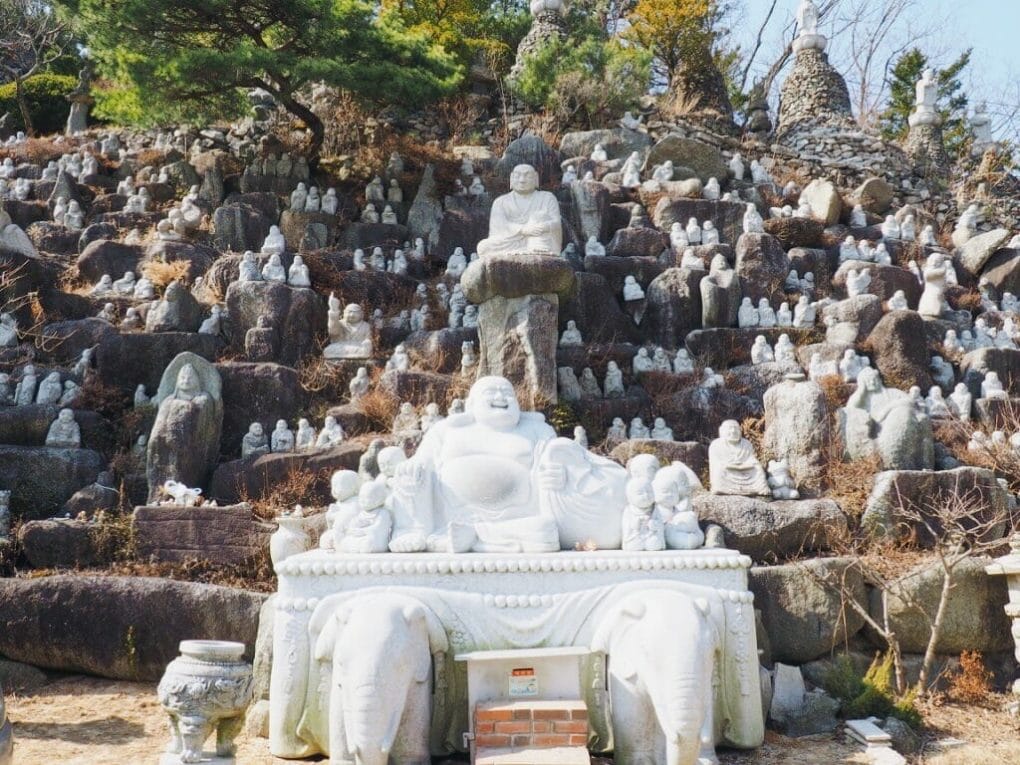
Gatbawi (갓바위).
Gatbawi is a famous stone statue of Buddha that sits 4 metres tall and is the section of Palgong Mountain that most people head to. It’s a popular pilgrimage (especially around Buddha’s birthday) to climb to the rock statue and bow 108 times.
How to get to Gatbawi.
Take the 401 bus to the last stop. From the final 401 bus stop, there are two routes to reach the peak. For both, start by following the concrete road uphill until you reach Gwanamsa Temple (관암사). There will be many other hikers you can follow as guidance.
The concrete steps then continue up to the left of the temple, or you can take the more scenic route to the right of the temple through the woods. To find this path head up the central steps of the temple, and bare right onto the forest trail. At the top of the climb you will reach a T-junction.
It’s well worth taking the 5-minute-totally-flat detour to the right to see Yong-jooam Hermitage (용주암), which has great views out over the ridge, plus a multitude of small Buddha statues. To return to the trail, re-trace your steps and this time take the left fork up to Gatbawi.
Not forgetting to get your free roasted chestnut from a local who merrily hands them out to all hikers. For both paths (depending on fitness and temple stops) it should take 1-1.5 hours to reach Gatbawi. Once at the top, you can see the statue, visit the gift shop, balance a coin on the rock and enjoy the views.
If you come during Buddha’s birthday season the whole area will be covered in colourful lanterns. It’s also popular to make the trek at sunrise or sunset, and therefore the concrete path is lit at night. However it’s not perfect so do bring a flashlight. On the far side of Gatbawi there are several more small temples you can visit, which are only a few minutes’ walk from the statue.
For more information about Gatbawi, visit here.
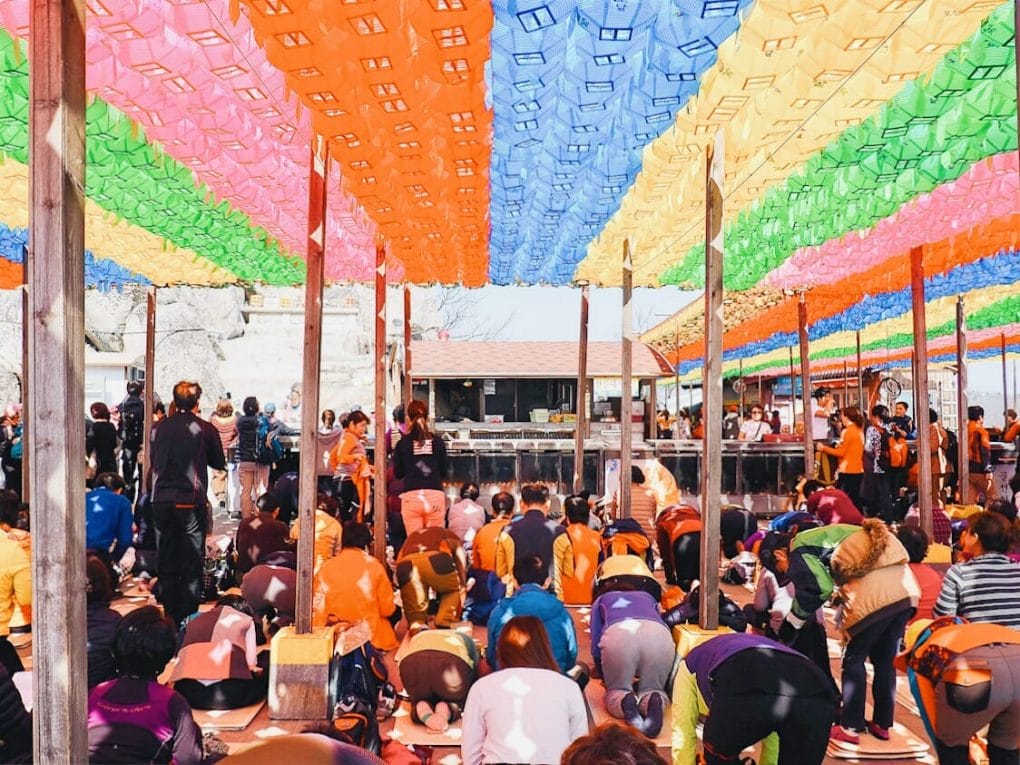
The Ridge.
My favourite section of the ridge is between the Dongbong Peak and Gatbawi. If you hike in this direction it’s slightly easier, but both ways are do-able. There’s just more ‘up’ going from the Gatbawi end. The path is clear for the most part, and you will meet other hikers on the trail.
Several times there are rocks you have to climb over, but these always have ropes. Just ensure you stay on the ridge, and you can’t go far wrong. This section of the ridge gives great views of Daegu to the south, and mountains to the north. On clear days you can see the peak, which is marked with satellite poles and telescopes, from Gatbawi.
My favourite descent off the ridge is at trail marker 38 – there are trail markers every several 100 meters or so. It’s halfway between the peak and Gatbawi, meaning you can ascend at either of these, and then come down in the centre of the ridge. The path ends at Donghwasa Temple.
It’s a clear path where you don’t have to watch every step, and it’s nice and gradual. You cross the river many times, so be sure to watch out for these turns if you can’t see the trail. There’s plenty of pools here to take a dip in if you want to cool down after hiking. Towards the end of the path, it’s easy to get lost. When you encounter a ruined stone hut, take the path to the right of it, which doesn’t border it.
There are small laminated signs pinned to the trees pointing to ‘Donghwasa Temple’ to help guide you but as long as you continue down, you should reach the road eventually.
You can also hike the western side of the ridge. The 101/101-1 buses go from downtown to Pagyesa Temple (파계사). From here there is a direct trail up to the ridge, however, you will have to pay a temple entrance fee of 1,500 won to use the path. Although still scenic, this section of the ridge has more tree cover, and therefore it doesn’t have the views of the eastern section.
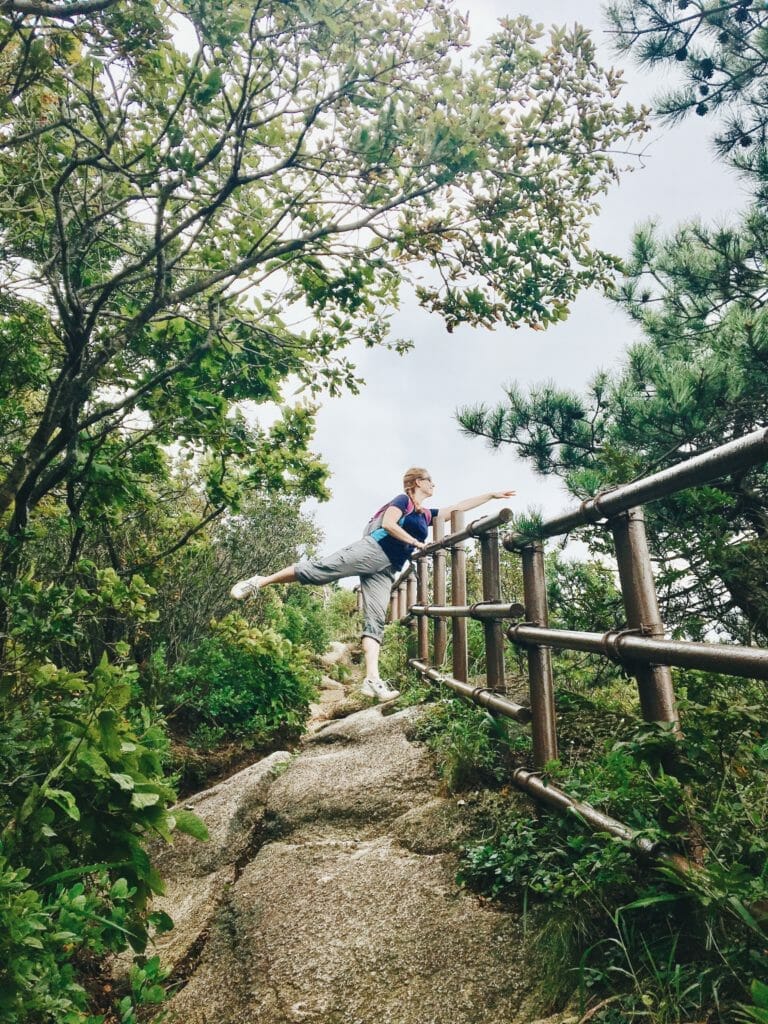
Donghwasa Temple to Dongbong Peak (동봉).
Donghwasa Temple is the largest and most famous Buddhist temple in Palgong Mountain. People come from all over Daegu and the country to enjoy the beautiful scenery and temple attractions. If you’re up for trying new things, you can even partake in a temple stay to truly experience devout Buddhist life in Korea.
How to get to Donghwasa.
There is a concrete road between Donghwasa Temple and Yombulam Hermitage, making it one of the quickest routes to the peak. To reach this road, get off at the Donghwasa Temple express 1 bus stop (동화사입구앞), and head up the hill to Donghwasa Temple.
To use this road you will have to pay the Donghwasa entrance fee of 2,500 won. After entering, cross the bridge and enter the car park – you will see the road in the left corner. To avoid this fee, turn left down the road just before the entrance to Donghwasa. Follow the wooden boardwalk trail next to the campsite.
This trail will run alongside the road after about 20-30 minutes, where you can cross over. From the hermitage you can fork left to the peak.For a more scenic path, take the boardwalk camping trail and simply follow it all the way to the peak. You will pass several stunning outlooks, including one over the cable car. You can also take the cable car, and then hike the remaining journey to the peak.
However the cable car only cuts out the easiest part of the hike and there is still a steep climb to go. Another scenic route option is to follow the path up from Sutaegol Valley. This well-worn path has several trails and is a good climb, so make sure you follow the signs. There are several waterfalls you’ll pass on this trail.
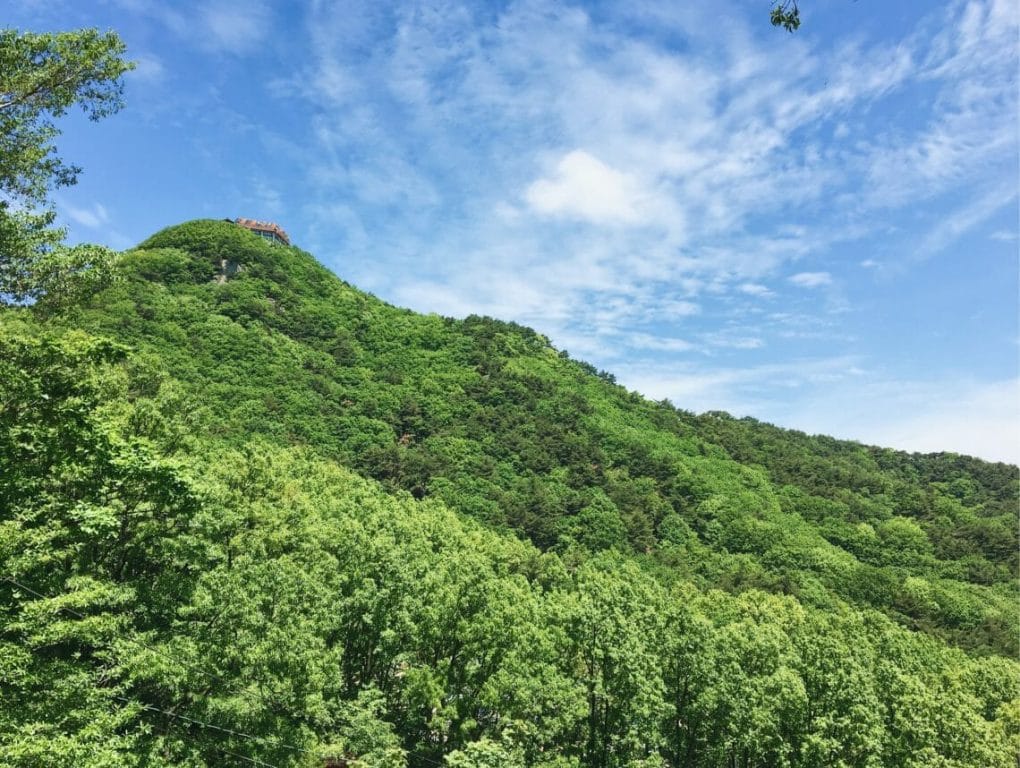
Things to see and do in Palgong Mountain
Palgongsan Road (팔공산로).
Palgonsan-ro, Dong-gu, Daegu 대구 동구 팔공산로
This road is famed for its colourful seasons. During springtime (usually mid-late April) the road is a tunnel of cherry blossoms. Due to the higher altitude, the Palgongsan bloom is a week or two later than central Daegu. In autumn (usually late October) the road turns colourful shades of reds, yellows, oranges and greens.
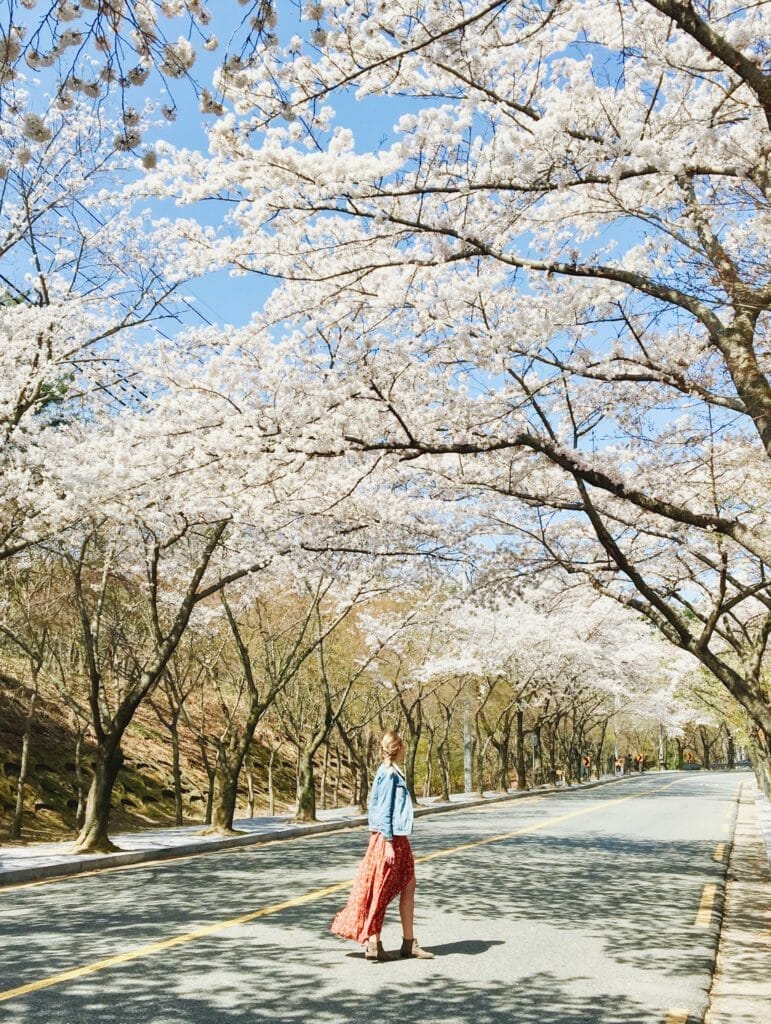
Things to note:
- Keep checking the bloom/foliage forecasts. Changes in rainfall/ temperature will change the peak dates.
- Try to go early or on a week day. From 10 am at the weekend the roads will be teeming with people having photo shoots, and cars crawling slowly along the road. The buses will also be heavily delayed due to the traffic jams.
- You can take the cable car to get a good view over the autumnal leaves, however expect to wait 1 hour+ for both your journeys up and back down.
Donghwasa Temple (동화사).
1, Donghwasa 1-gil, Dong-gu, Daegu 대구광역시 동구 동화사1길 1 (도학동)
One of the most popular temples in Daegu, it’s easy to access, plus with ample parking for those who drive. If you enter via the main gates expect to pay 2,500 won per adult. The 1st gate is located a 10 min uphill walk from the express 1 bus stop동화교1, and the 2nd is a 10 minute more gentle (but still uphill) walk from the express 1 bus stop 동화사입구앞.
The latter being more scenic as it crosses a lake. However if you enter from one of the mountain trails, it’s totally free. They offer a foreigner friendly temple stay programme, and if you go with Better Together on their annual trip – it’s free! For more information about Donghwasa Temple, visit here.
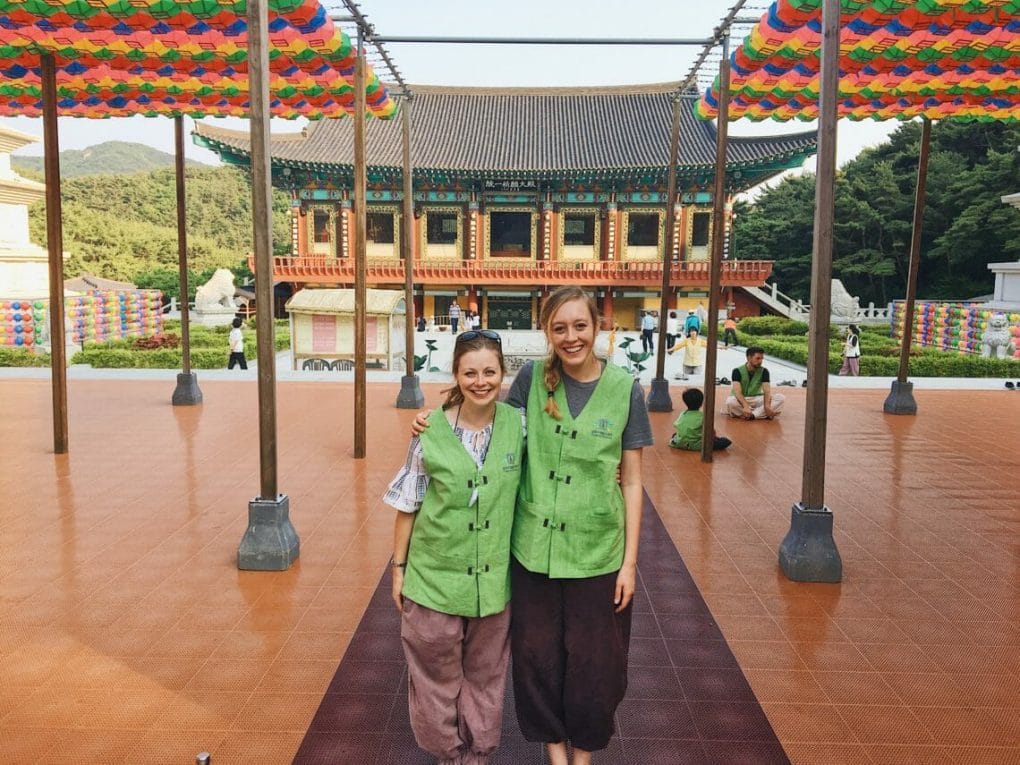
Sutaegol Valley (수태골).
This isn’t the easiest spot to reach in the park but it’s well worth it. If you have a car, there is ample parking just off the main road. If not it’s a 20 min walk along the road from the last stop of the express 1 bus (동화시설집단지구).
Once you reach the car park, follow the concrete path (that turns into a trail) for about 10 minutes uphill. You’ll pass multiple toilets and changing facilities. Keep an eye out on your left. There is a hidden turn off descending down several meters to the base of the waterfall. You can hear the waterfall from the trail.
Once there you can frolic and swim to your hearts content. The rock face may look intimidating, but it’s perfect for sliding down and splashing into the pool below. Just make sure the water levels are high enough before you go, during dry spells the waterfall disappears.
There are usually several laminated fried chicken menus tied to the trees, for when you’re in need of a snack.
Check out Little Green Field Book’s post here for more photos and information about their experiences in Sutaegol Valley.
Cable Car (팔공산 케이블카).
51, Palgongsan-ro 185-gil, Dong-gu, Daegu 대구광역시 동구 팔공산로185길 51
(용수동) The cable car starts from the central restaurant area of Palgong Mountain and takes you halfway up the mountain. At the top, there is a restaurant and a scenic boardwalk along a small ridge. On a clear day you have views of Daegu to the south, and up across the valley to the peak in the north.
For more information about the cable car, read about it here.
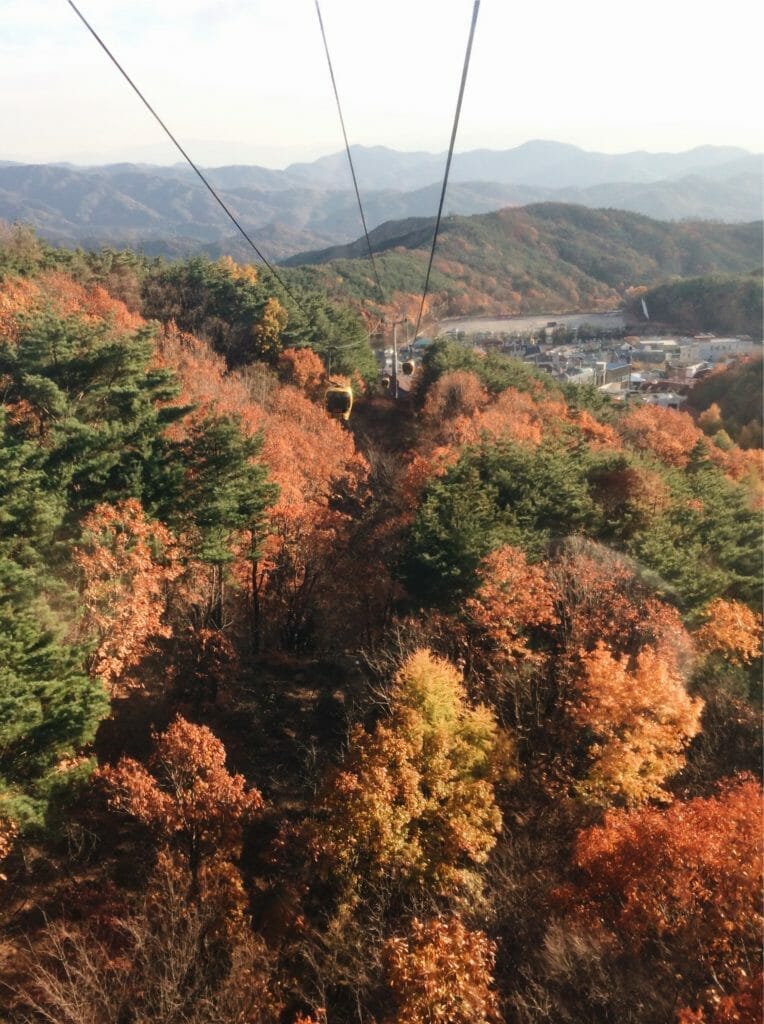
Café Street.
818-3, Jungdae-dong, Dong-gu, Daegu, Korea. 대구 동구 중대동 819-2This street is lined with cafes, and is a famous date spot for locals who want to enjoy coffee and cake with a view. With all the usual chain cafes such as Starbucks and Davinci, you can get your caffeine fix in the mountains. There is also one of the more elaborate temples I’ve seen in Korea – Dalmasa Temple (달마사).
Several of my favourites are:
The Secret Garden Café (팔공산시크릿가든) for coffee in a garden.
경북 칠곡군 동명면 득명2길 97-21
Fraganza (프라그란자) to sit on a bean bag and watch the world go by.
대구광역시 동구 중대동 758-3
758-3 Jungdae-dong, Dong-gu, Daegu
Pagaemaru (파계마루) to enjoy traditional tea and food in a hanok.
대구 동구 파계로 613.
613, Pagye-ro, Dong-gu, Daegu, Korea
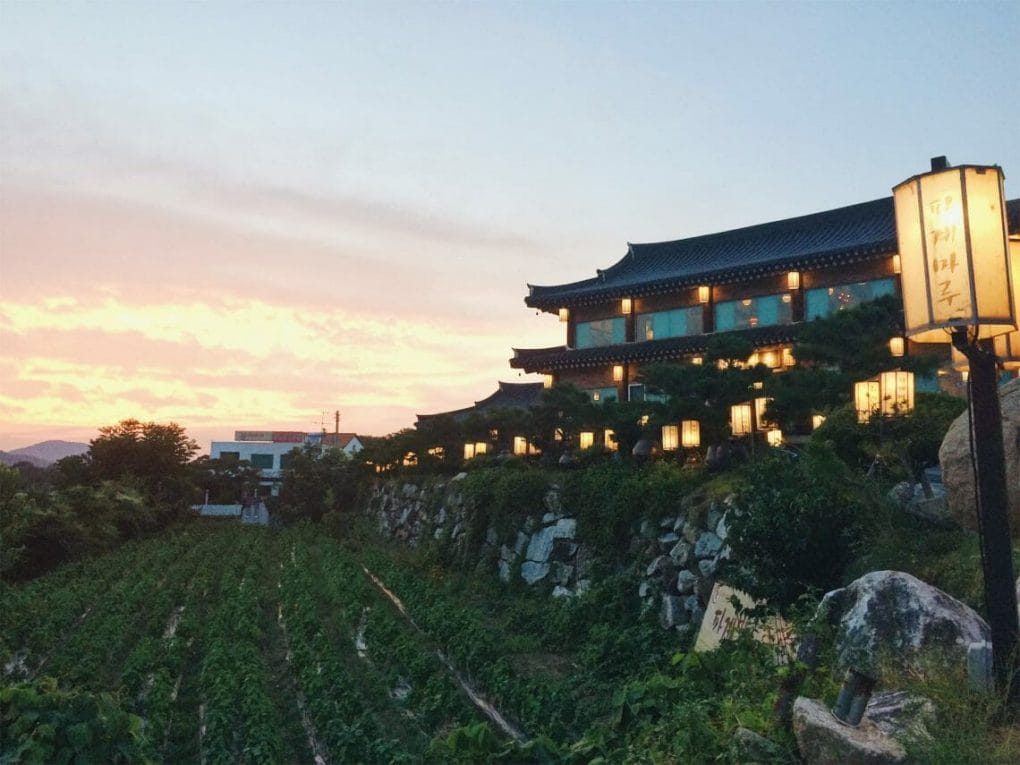
Extra Information For Hiking Palgongsan.
Weather
The weather at Palgong Mountain is noticeably cooler than central Daegu. On days where it’s cooler and raining in the city, chances are it’s snowing on the mountain. Twice I’ve got caught in the snow unexpectedly on Palgongsan – so do beware!
Similarly I’ve hiked the mountain in the middle of the sweltering Daegu summers, and it’s been a welcoming, cooling rest bite. The majority of the trails, and even the ridge are in the shade, so you only have the humidity to contend with.
Animals
Although not teeming with wildlife, Palgongsan does have some to note. I’ve seen a family of wild boars (with huge tusks), deer, water snakes, pheasants, chipmunks, plus all the usual bugs and birds. Just be wary when out and about.
Facilities
All of the temples on the mountain have toilets and water. The Gatbawi trail even has toilets dotted along the way. I’ve drunk the temple water on many occasions and never had any issues.
More Korean Hiking Tips
Other sites near Palgong Mountain.
- Bullo-dong Ancient Tomb Park
- Bongmu Lake (inc watersports such was water skiing, plus a butterfly museum)
- Bangjja Brassware Museum
- Daegu Safety Theme Park
- Daegu Textile Museum
- Hannah (animal) Shelter
- Dong-gu Arbor Vitae Forest
- Otgol Hanok Village
- Esiapolis Lotte Outlet Shopping Mall
Read more: Tips for Hiking in South Korea
What tips do you have for Palgong Mountain? Share below!
Author
Hannah is a travel addict from London, most at home when drinking coffee or climbing mountains. She has been living in the Palgong Mountain area for two years, and dreams to hike the highest peak on each continent.
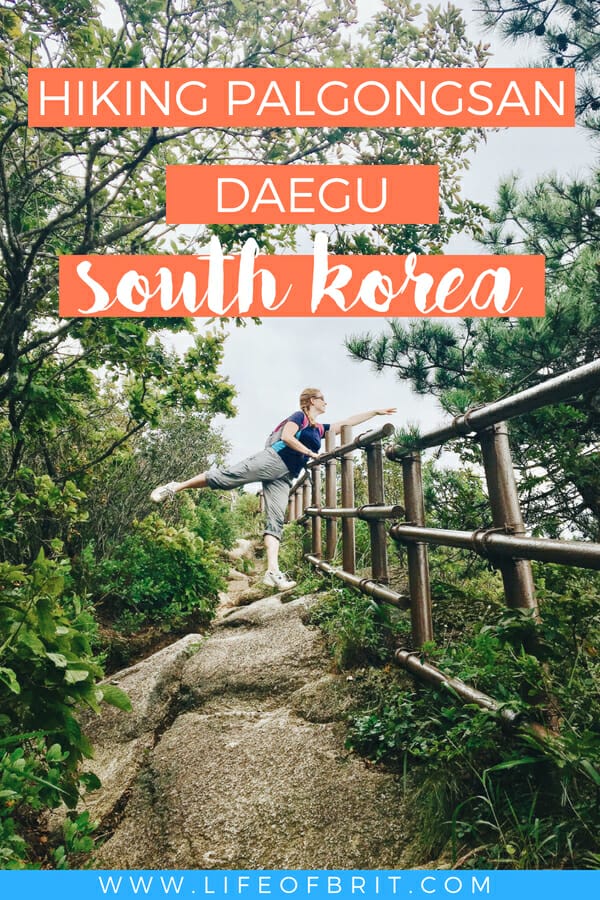

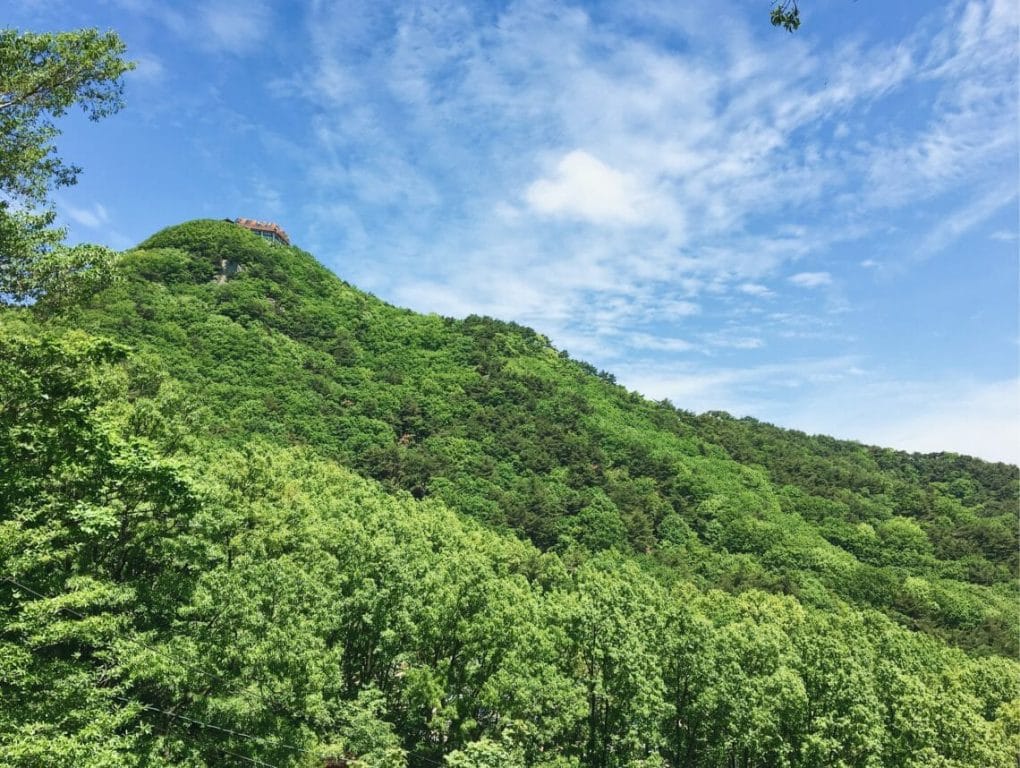
Great post! I’m living in a small town right in front of Palgong Mountain with my wife and a boy. We moved in here last November, 2017. Though I am a Korean, this post helps me alot. Thanks! Sorry for my bad English and have a good day!
Wow I am so happy to hear this was helpful! Welcome to Palgongsan – it is a nice area so close to nature 😀 And your English is perfect 😀 Take care!
Awesome. Will have to check it out hopefully one day when I return!
Very useful information! I was just at Palgongsan this April and had only a morning to hike so the tip about coming down at marker 38 was great.